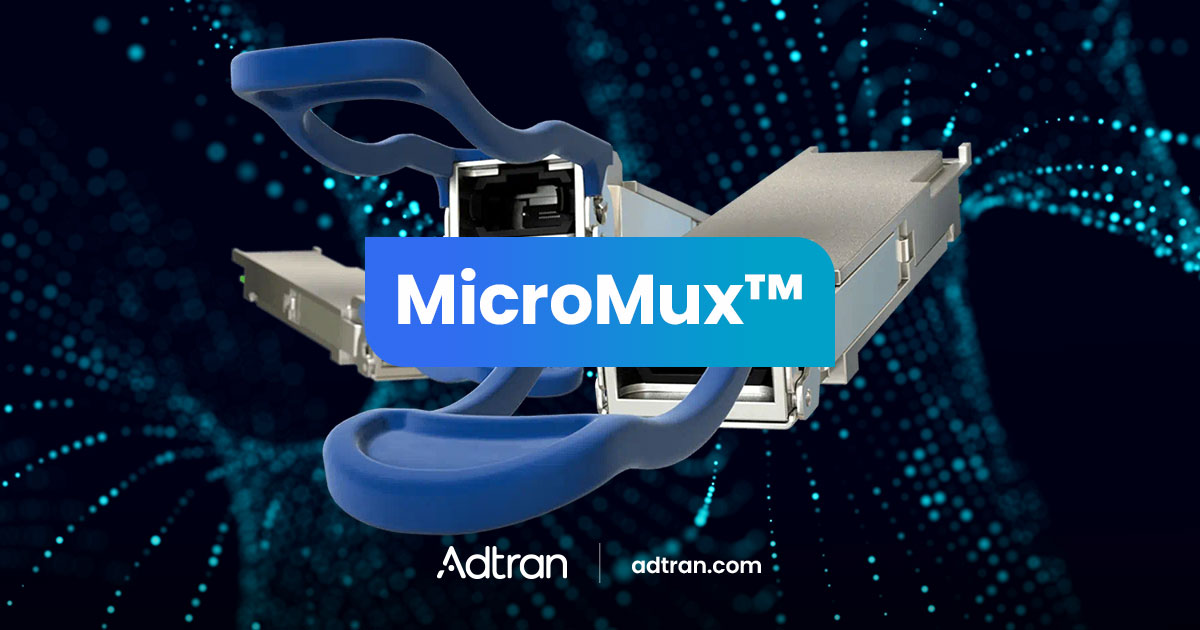ADVA expands industry’s smallest aggregation solution for the edge and the core
News summary:
- Operators need to optimize the capacity of their transport and DCI networks without large increases in cost or complexity
- New MicroMux™ series extends the value of existing aggregation devices with plug-and-play simplicity
- Pluggable multiplexers key to helping operators reduce space, power and operating costs
ADVA (FSE: ADV) today expanded its MicroMux™ series of pluggable devices with two new models. The MicroMux™ Nano and the MicroMux™ Quattro now enable network operators to maximize the value of their existing aggregation devices both at the edge and in the core. The two new high-density multiplexers focus on helping customers reduce operational complexity, lower capital expenditures and fully exploit the potential of their existing hardware. The ADVA MicroMux™ Nano fits into 10GbE sockets and fans out ten 1GbE interfaces, bringing new levels of flexibility and efficiency to the network edge. At the other end of the scale, the MicroMux™ Quattro converts 400GbE client ports into four 100GbE ports, reducing cost and complexity at the core. The unique portfolio of standards-compliant multiplexers provides a way to affordably scale data center access and transport networks while meeting legacy needs.
“Our comprehensive portfolio of multiplexers in a plug enables a fresh approach to expanding infrastructure. It empowers operators to balance current requirements with tomorrow’s demands, protecting previous investments while ensuring future-proof growth. With our MicroMux™ series, there’s no need to replace entire systems or add expensive and bulky equipment. Operators are free to easily convert 10Gbit/s, 100Gbit/s or 400Gbit/s interfaces into multiple lower-speed interfaces with zero footprint increase,” said Stephan Rettenberger, SVP, marketing and investor relations, ADVA. “Today’s launch highlights the importance of our open optical technology for an industry juggling soaring data demand with challenging performance, simplicity and cost objectives. Now there’s a plug-and-play solution for all aggregation needs that smoothly upgrades legacy infrastructure without compromising space, power or spectral efficiency. With our new MicroMux™ family, operators can harness a seamless mix of speeds for ultimate efficiency and value.”
With our technology, operators can tackle future demand at the same time as meeting legacy needs.
The ADVA MicroMux™ Nano is the first device of its kind specifically engineered for the network edge. Requiring no additional equipment, the Layer 2 Ethernet multiplexer easily slots into existing SFP+ client ports, turning 10GbE into ten 1GbE interfaces without inflating cost. Next in size is the original MicroMux™. With over 10,000 deployed in commercial networks, this QSFP28 module is already delivering true scale and flexibility to global cloud and internet service providers by converting 100GbE to ten 10GbE channels. At the core of the network where much higher data rates are required, the ADVA MicroMux™ Quattro aggregates four 100GbE streams into a 400GbE QSFP-DD plug with no increase in footprint. Extremely simple to deploy, all three MicroMux™ plugs provide a major boost to client port density without waste, ensuring no stranded bandwidth and no loss of total system capacity.
“Our MicroMux™ range is the result of close collaboration with leading transport network and DCI operator customers looking to meet both legacy needs and future demands. With more than 10,000 of our original MicroMux™ modules already deployed, our pluggable muxponders are right now helping operators across the globe to tackle the most urgent challenges around cost and scale while supporting a true pay-as-you-grow model of network expansion,” commented Ross Saunders, GM, Optical Engines, ADVA. “Our MicroMux™ technology makes it easy to upgrade a link without having to replace the whole system. They also deliver superb energy efficiency. What’s more, the whole family comes in several variants to accommodate all distances and fiber types. So, whether it’s single or multimode fiber over short, intermediate or long-reach links, network operators have the tools available to optimize space, power and operating costs.”
Related resources
 ;
;




